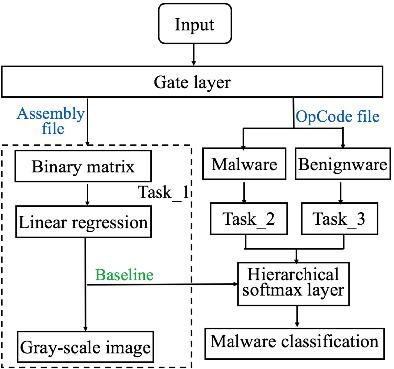当前位置:
X-MOL 学术
›
Trans. Emerg. Telecommun. Technol.
›
论文详情
Our official English website, www.x-mol.net, welcomes your
feedback! (Note: you will need to create a separate account there.)
An internet of things malware classification method based on mixture of experts neural network
Transactions on Emerging Telecommunications Technologies ( IF 2.5 ) Pub Date : 2020-04-29 , DOI: 10.1002/ett.3920 Fangwei Wang 1, 2, 3 , Shaojie Yang 1 , Qingru Li 1, 2, 3 , Changguan Wang 1, 2, 3
Transactions on Emerging Telecommunications Technologies ( IF 2.5 ) Pub Date : 2020-04-29 , DOI: 10.1002/ett.3920 Fangwei Wang 1, 2, 3 , Shaojie Yang 1 , Qingru Li 1, 2, 3 , Changguan Wang 1, 2, 3
Affiliation

|
With the rapid development of the internet of things (IoT) technology, IoT devices have brought great convenience to agriculture, industry, and our daily lives. However, there exist numerous vulnerabilities and lack of efficient protective measures in IoT, thus its devices can be easily infected by malware. It is of great importance to improve the accuracy of malware classification for detecting and preventing the IoT malware. In this article, we adopt the mixture of experts (MoE) neural network to analyze and classify the family of the IoT malware. A classification framework is proposed based on the MoE neural network which utilizes the multitask learning approach and is designed to train multiple neural networks, each of which is responsible for a set of data and tasks. The proposed framework contains three neural networks which are designed to analyze and classify the malware and benignware samples. Especially, an improved hierarchical softmax algorithm based on the MoE neural network is used to distinguish the malware from benignware and get its exact classification. Experiment results show that the presented MoE neural network model can effectively distinguish the malware and benignware. Besides, the MoE neural network is also effective for malware family classification. The comparison of experiment results with other literatures shows that the proposed classification method has better performance.
中文翻译:

基于专家神经网络混合的物联网恶意软件分类方法
随着物联网(IoT)技术的飞速发展,物联网设备为农业,工业和我们的日常生活带来了极大的便利。但是,物联网存在众多漏洞,缺乏有效的防护措施,因此其设备很容易受到恶意软件的感染。提高检测和预防IoT恶意软件的恶意软件分类的准确性非常重要。在本文中,我们采用专家混合(MoE)神经网络对IoT恶意软件家族进行分析和分类。提出了一种基于MoE神经网络的分类框架,该框架利用多任务学习方法并旨在训练多个神经网络,每个神经网络负责一组数据和任务。提议的框架包含三个神经网络,旨在分析和分类恶意软件和良性软件样本。尤其是,使用一种基于MoE神经网络的改进的分层softmax算法来区分恶意软件与良性软件,并对其进行精确分类。实验结果表明,提出的MoE神经网络模型可以有效地区分恶意软件和良性软件。此外,MoE神经网络对于恶意软件家族分类也是有效的。实验结果与其他文献的比较表明,该分类方法具有较好的性能。一种基于MoE神经网络的改进的分层softmax算法,用于区分恶意软件和良性软件并获得准确的分类。实验结果表明,本文提出的MoE神经网络模型可以有效地区分恶意软件和良性软件。此外,MoE神经网络对于恶意软件家族分类也是有效的。实验结果与其他文献的比较表明,该分类方法具有较好的性能。一种基于MoE神经网络的改进的分层softmax算法,用于区分恶意软件和良性软件并获得准确的分类。实验结果表明,本文提出的MoE神经网络模型可以有效地区分恶意软件和良性软件。此外,MoE神经网络对于恶意软件家族分类也是有效的。实验结果与其他文献的比较表明,该分类方法具有较好的性能。
更新日期:2020-04-29
中文翻译:

基于专家神经网络混合的物联网恶意软件分类方法
随着物联网(IoT)技术的飞速发展,物联网设备为农业,工业和我们的日常生活带来了极大的便利。但是,物联网存在众多漏洞,缺乏有效的防护措施,因此其设备很容易受到恶意软件的感染。提高检测和预防IoT恶意软件的恶意软件分类的准确性非常重要。在本文中,我们采用专家混合(MoE)神经网络对IoT恶意软件家族进行分析和分类。提出了一种基于MoE神经网络的分类框架,该框架利用多任务学习方法并旨在训练多个神经网络,每个神经网络负责一组数据和任务。提议的框架包含三个神经网络,旨在分析和分类恶意软件和良性软件样本。尤其是,使用一种基于MoE神经网络的改进的分层softmax算法来区分恶意软件与良性软件,并对其进行精确分类。实验结果表明,提出的MoE神经网络模型可以有效地区分恶意软件和良性软件。此外,MoE神经网络对于恶意软件家族分类也是有效的。实验结果与其他文献的比较表明,该分类方法具有较好的性能。一种基于MoE神经网络的改进的分层softmax算法,用于区分恶意软件和良性软件并获得准确的分类。实验结果表明,本文提出的MoE神经网络模型可以有效地区分恶意软件和良性软件。此外,MoE神经网络对于恶意软件家族分类也是有效的。实验结果与其他文献的比较表明,该分类方法具有较好的性能。一种基于MoE神经网络的改进的分层softmax算法,用于区分恶意软件和良性软件并获得准确的分类。实验结果表明,本文提出的MoE神经网络模型可以有效地区分恶意软件和良性软件。此外,MoE神经网络对于恶意软件家族分类也是有效的。实验结果与其他文献的比较表明,该分类方法具有较好的性能。











































 京公网安备 11010802027423号
京公网安备 11010802027423号